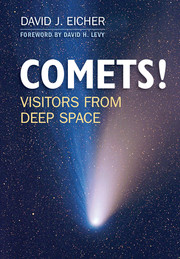Book contents
- Frontmatter
- Dedication
- Contents
- List of Figures
- List of Plates
- Foreword
- Preface
- Acknowledgments
- 1 Strange Lights in the Sky
- 2 Great Comets
- 3 What Are Comets?
- 4 Comets of the Modern Era
- 5 Comets in Human Culture
- 6 Where Comets Live
- 7 The Expanding Science of Comets
- 8 Observing Comets
- 9 Imaging Comets
- Glossary
- Bibliography
- Index
- Plate Section
9 - Imaging Comets
Published online by Cambridge University Press: 05 October 2013
- Frontmatter
- Dedication
- Contents
- List of Figures
- List of Plates
- Foreword
- Preface
- Acknowledgments
- 1 Strange Lights in the Sky
- 2 Great Comets
- 3 What Are Comets?
- 4 Comets of the Modern Era
- 5 Comets in Human Culture
- 6 Where Comets Live
- 7 The Expanding Science of Comets
- 8 Observing Comets
- 9 Imaging Comets
- Glossary
- Bibliography
- Index
- Plate Section
Summary
A generation ago, capturing your own photographic portraits of the sky was a difficult and complex process. Cameras could be tricky, choosing the right film was an arduous process, and technology simply wasn’t what it is today – the process of guiding your telescope accurately as Earth rotated and the sky seemed to move could be such an exacting process that it drove people crazy. Now, producing high-quality pictures of the sky is still a somewhat tricky process, but it’s much easier than it used to be.
As with any sky targets, you can capture pictures of comets in a variety of ways. Astronomical objects are very faint compared with normal scenes of people at the beach, so long exposures are generally needed, regardless of the equipment setup or technique used.
Types of comet photography range from pretty simple to quite complex and of course demand increasing sophistication of equipment and knowledge. The easiest way to capture a comet is simply to mount a camera on a tripod, fitted with a wide-field lens, and shoot an unguided exposure that will capture the comet amid constellations. More ambitious is to mount your camera “piggyback” style on a guided platform or telescope, to capture a time exposure of a smaller field of view that tracks the sky to preserve small, round star images. The most sophisticated method is prime focus photography, in which the camera is attached to the telescope and the telescope is used as a giant lens. Because of the high resolution and small field of view, the tracking must be superb and the exposure calculated to capture the desired details in the comet. All three basic methods will be discussed in this chapter.
- Type
- Chapter
- Information
- COMETS!Visitors from Deep Space, pp. 171 - 186Publisher: Cambridge University PressPrint publication year: 2013



